Matt Strassler [February 6, 2013]
Now let’s turn to the question of whether the new Higgs-like particle, even if it is the only type of Higgs particle found in nature, might not be a Standard Model Higgs particle (the Higgs particle of simplest possible type.) This is something that I addressed extensively in my talk at the Higgs Symposium.
In the Standard Model (the equations we use to describe all the known elementary particles and forces, plus the simplest Higgs), there is only one Higgs field and one Higgs particle; and once the particle’s mass is known, everything else about it can be computed [though in practice not all the calculations can be done with extremely high accuracy, because of their difficulty and/or because of uncertainties about internal properties of protons.] Among the things we can predict, as I have described in my articles on Standard Model Higgs production and Standard Model Higgs decay, are
- in what ways (and for each way, at what rate) Standard Model Higgs particles are produced in proton-proton collisions at the Large Hadron Collider [LHC]
- in what ways Standard Model Higgs particles decay (and for each way, what fraction of Standard Model Higgs particles decay this way)
For instance, Higgs particles may be produced, from largest rate to smallest,
- (mainly) by themselves, or
- with two additional quarks, or
- with a W particle, or
- with a Z particle, or
- with a top quark/anti-quark pair.
And predominantly Standard Model Higgs particles are predicted to decay (from most likely to least likely)
- to a bottom quark/anti-quark pair,
- to one real and one virtual W particle,
- to a pair of gluons, (unfortunately not measurable at the LHC)
- to a tau lepton/anti-lepton pair,
- to a charm quark/anti-quark pair, (unfortunately not likely measurable at the LHC)
- to one real and one virtual Z particle,
- to a pair of photons
- to a photon and a Z particle
Now if instead the Higgs-like particle is not a Standard Model Higgs particle, then we can look for
- production rates that differ from what is predicted for a Standard Model Higgs particle
- decay fractions that differ from what is predicted for a Standard Model Higgs particle
- ways that the Higgs-like particle is produced that are not expected for a Standard Model Higgs particle
- ways that the Higgs-like particle decays that are not expected for a Standard Model Higgs particle
To address the first two of these questions requires relatively precise measurements, because — crudely speaking — we can already tell that in the 2011-2012 data there are no dramatic violations of what the Standard Model predicts. With 2/3 of the 2011-2012 data already analyzed, we’re very unlikely to see anything convincingly amiss in these measurements when the analysis of the full data set appears this spring. There’s a possible exception in the Higgs-like particle’s probability to decay to two photons, which is a little high right now. But it is almost certain that more data will be needed before we’ve any hope of a striking challenge to the Standard Model’s predictions for expected modes of production and decay.
However — and this is a point I’ve been emphasizing a lot — unexpected production or decay of the Higgs is something that still has barely been looked for in the 2011-2012 data. There could be something quite striking in the already-collected data that we wouldn’t yet know about. And therefore (as I’ve been arguing, along with many others, see for example here) a systematic program searching for unexpected production or decay of the Higgs-like particle should be undertaken at the LHC experiments ATLAS, CMS and (for certain unexpected decays) LHCb. Even the Tevatron experiments DZero and CDF might want to look in their data. Such a program could potentially lead to a major discovery this year or next, even while the LHC isn’t collecting new Higgs particles!
If you accept this argument, at least provisionally, then your next question will be: well, how should we look for unexpected Higgs production or decay?
Conveniently, the decay of a particle is independent of how it is produced, and vice versa. So if you’re looking for the Higgs-like particle (and from now on I’ll usually just call it “the Higgs” for brevity) to be produced in an unusual fashion, you can assume it decays in a standard fashion — and vice versa. So we’ll be looking for Higgs particles that decay as expected, but were produced along with something that wasn’t expected! And we’ll be looking for Higgs particles that were produced as in the Standard Model, but disintegrate into something unusual.
Unexpected Production of the Higgs-Like Particle
In speculative theories that go beyond the Standard Model, a very common way for Higgs particles to be produced is in the decay of some other heavy particle. Now there’s only one known heavy particle that’s heavier than the Higgs, and that’s the top quark. And indeed, in some theories, the top quark can decay rather often to a Higgs particle plus a charm quark or an up quark. Because such decays are far too rare to observe in the SM, detecting this process would imply that there must be new particles and forces in nature, most likely accessible at the LHC. Now that would be cool! Already my colleagues at Rutgers have put a limit on this possibility, by looking at the number of three-lepton events observed in CMS data. [Here “lepton” is shorthand for electron, muon, tau or their anti-particles]. They claim that at most 2.7% of top quarks decay to Higgs particles. But this is just a start. With millions of top quark/anti-quark pairs produced at both ATLAS and CMS, much better limits should be possible with dedicated searches.
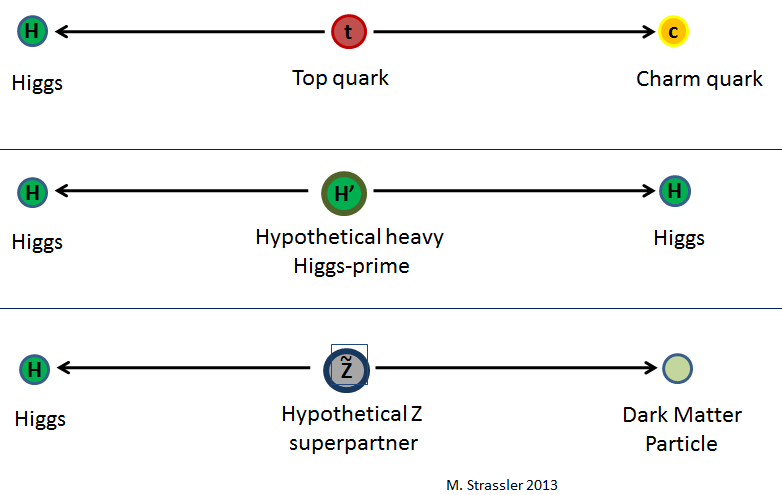
Meanwhile, if there are heavy particles we haven’t discovered yet, then there are quite a few other possibilities. For instance, a heavy version of the top quark, often called a top-prime (see this page or this page for some discussion) could decay to a top quark plus a Higgs. A heavy version of the W or Z particle (called a W-prime or a Z-prime) could decay to a W or Z plus a Higgs. Or a heavy Higgs particle that we haven’t discovered yet could decay to two of the Higgs particles we’ve already found. Superpartners of the Z or Higgs particles could decay to a Higgs particle plus something else, such as undetectable dark-matter particles (whose presence would be inferred through an imbalance of the momentum of the observed particles.) And so on. These cases would be particularly exciting because not only would observation reveal the new Higgs-like particle isn’t actually a Standard Model Higgs particle, it simultaneously would result in the discovery of at least one new particle that is heavier than the Higgs itself!
I should remind any experts that might be reading this that while looking for the newly discovered particle, one should always keep an eye out for the possibility of other Higgs-like particles that might have a different mass and also might be produced in an unusual way. That is, one should typically pursue a blind search for the known particle with a mass of 125 GeV/c2, and simultaneously do a non-blind search for particles that decay in similar ways but have a different mass. Typically, for these two purposes, most of the data analysis is the same or similar, and only the statistical treatment of the result is significantly different.
Unexpected Decays of the Higgs-like Particle
This is a favorite topic of mine; you’ve probably noticed, since it has appeared numerous times on this blog (see for example here and here). As have a number of my colleagues, I’ve written some papers about it, and I’ve worked on it with many experimentalists from the Tevatron experiments DZero and CDF and the LHC experiments ATLAS, CMS and LHCb.
The reasons this seems to me to be so important are several.
First, very generally, once you have actually discovered a new particle, and you know its mass and how it is produced, it becomes much, much easier to look for it to decay in an unexpected fashion. That is because the look-elsewhere effect (see also here for a more general discussion) is eliminated; rather than needing to look for unexpected behavior of an unknown particle that might have any possible mass, you’re now looking for a known particle of known mass (125 GeV/c² in this case) to do something you don’t expect. That’s a much more specific question, one that is less subject to statistical flukes and can be answered with greater precision.
Second, there’s tremendous potential in searching for unusual decays, even very rare ones, because the Higgs-like particle was produced in great abundance in 2011 and 2012. Assuming its production rate is similar to that of a Standard Model Higgs particle (and all evidence suggests this is the case), at least 500,000 Higgs-like particles were produced at ATLAS and a similar number at CMS. (Over 80% of them were produced in 2012.) So a decay which occurs only once in 100 Higgs particles occurred 5000 times in 2011-2012 at each experiment; one that occurs only once in 10,000 Higgs particles occurred 50 times. That’s a huge amount of opportunity sitting there, just waiting in the data for experimentalists to seek.
Third, a Higgs particle of mass below about 140 GeV/c2 is very sensitive to new particles or forces. All the decays of a lightweight Standard Model Higgs particle occur through processes that are suppressed in one way or another. Consequently, unexpected effects whose strength is quite small indeed — say, 1000 times smaller than the effect of a Higgs particle on a W particle — could lead 1 in 10,000 Higgses to decay in an unexpected way. And any experienced particle theorist will tell you that it is very easy to get effects of that size, or even much larger, for a spin-0 particle like the Higgs!
Fourth, there are few existing experimental or theoretical constraints on this possibility, except that current LHC data suggest the new particle doesn’t decay in an unexpected fashion a majority of the time. But still, if 1 in 5 Higgs particles decayed in an unusual way — 100,000 of them at ATLAS and 100,000 at CMS — we wouldn’t necessarily yet know it.
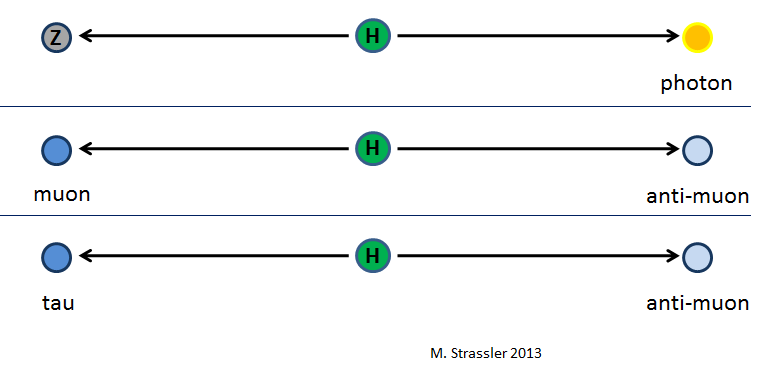
So in summary: for any newly discovered particle, we should always look for unexpected decays; and in a case where the new particle has been abundantly produced and is very sensitive to unknown phenomena, the imperative to look for such phenomena is overwhelming. Add to this that no new data will arrive til 2015, and the importance of this program over the next two years becomes very clear.
Now what types of decays are we talking about?
One possibility is that the Higgs could decay to particles we already know about, but do so in an unexpected fashion. This could include decays that are very rare or absent in the Standard Model:
- Higgs → photon + Z particle
- Higgs → muon/anti-muon pair
- Higgs → tau + anti-muon (or anti-tau + muon)
It is well worth trying to measure these decays even though the SM predicts they will be too rare to observe anytime soon or at all; perhaps the SM is wrong about this!
But another possibility — one that I feel is often overlooked by both my theoretician and experimentalist colleagues, partly because of a sociological bias that I worry a lot about — is that the Higgs could decay to particles that we haven’t discovered yet. These new particles would have to be lighter than the Higgs; in fact, if the Higgs decayed to a particle/anti-particle pair, then those particles would have to have mass below half the Higgs mass (about 63 GeV/c2). I am often asked: Are such lightweight unknown particles, lighter than the W and Z particle masses, possible? Wouldn’t we have discovered them already?
The answer is no, and the reason is along the same lines of why the top quark, with a mass of about 173 GeV/c2, was discovered before the Higgs particle, which has a lower mass. The top quark interacts more strongly with ordinary matter than the Higgs particle does — in particular, with the stuff that makes up protons — and so it is easier to produce, even though it is heavier. Carrying the same logic further, it is possible that particles that are very light indeed, but interact very weakly with ordinary matter, may have been overlooked at previous accelerators. Even though there may have been plenty of energy per collision to produce them, the rate for producing them may have been so small that they were never produced at all. Or they may have been produced so rarely that they went unnoticed. They may have been rendered undiscoverable by other well-known processes that may have mimicked their presence and hidden them like flecks of gold in a pile of pyrite (“fool’s gold”).
But for such a lightweight particle to have been missed, it must be affected neither by the electromagnetic force nor by the strong nuclear force — nor even by the weak nuclear force, for particles much lighter than the Z or W particle. In short, these particles will likely be “singlets” (see the article in this series on supersymmetry), which means they are affected by none of the three non-gravitational, non-Higgs forces.
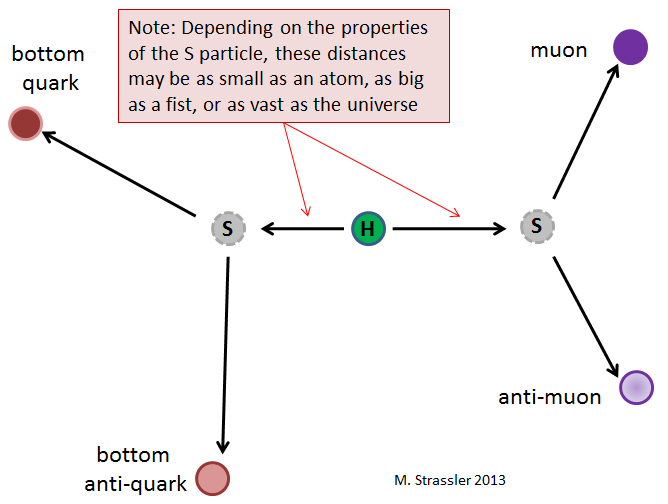
So lightweight singlet particles may exist without us knowing about them yet; and if they do, then if the Higgs particle interacts with them even a little bit, it may be able to decay to them. How will we know? That depends on what happens next.
Singlets, since they do not interact strongly with ordinary matter, will leave no visible signs in an experimental detector like ATLAS or CMS or LHCb. So if they pass through the detector before they decay (if they decay at all), then they, like neutrinos and dark matter particles, will be undetected. Their presence can be inferred only through the momentum that they carried off, which leaves an imbalance in the momentum of those objects that were detected, called “missing transverse momentum” or (inaccurately but commonly) “missing energy”. (This is a common feature of classic variants of supersymmetry, but can occur for many other reasons.) A decay where everything that the Higgs decays to is undetectable is what physicists colloquially call an “invisible decay”. There is currently an active effort to try to discover any signs that Higgs particles sometimes decay invisibly. The same effort would be sensitive to Higgs particles decaying to neutrinos (which is supposed to happen only rarely) or to dark matter particles (about which we know almost nothing.)
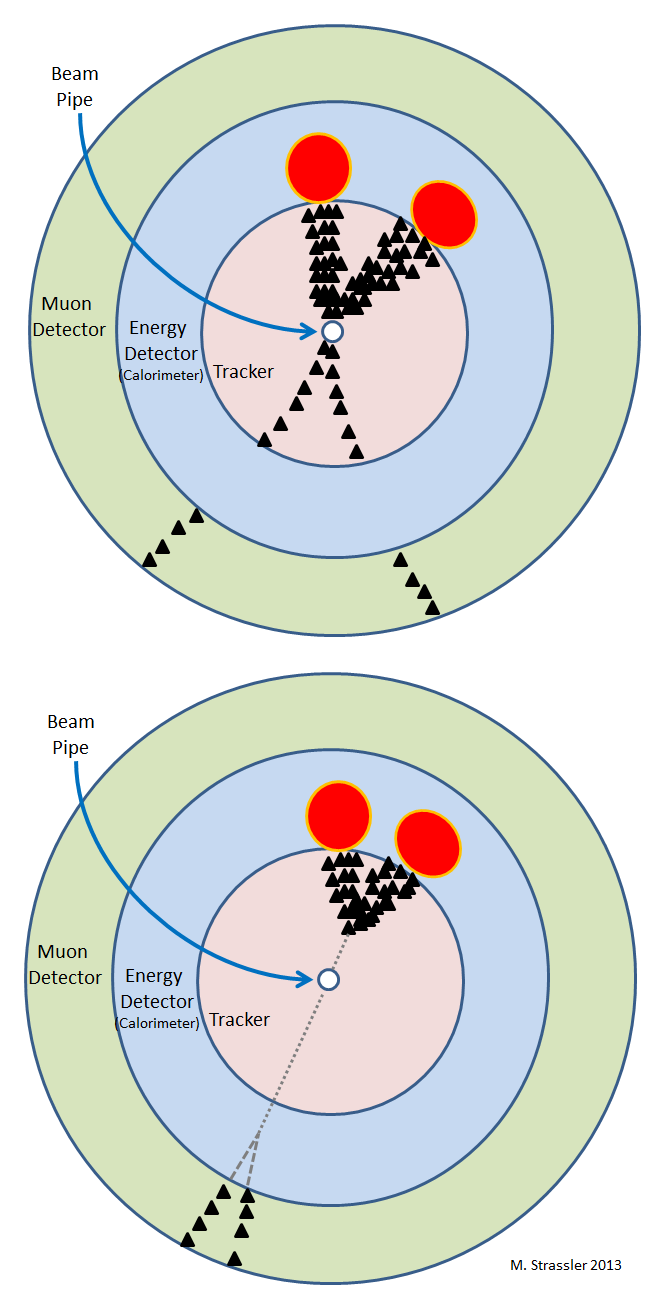
But another possibility is that some or all of the singlets produced in a Higgs decay do decay almost immediately, or, more exotically, while crossing the bulk of the detector. And in this case the number of possible signals that the Higgs might produce in the detector is very large indeed, because it depends on
- how many singlet particles were produced in the Higgs particle’s decay?
- what are the singlet particles’ masses?
- were some of them clustered together, or were they traveling in very different directions?
- what observable particles did they decay to?
- where did they decay to them?
An example of just one of the vast array of possibilities is shown in Figure 3 (and a more complex one is shown in Figure 5). Whether the lifetime of the S particle is long, short or moderate determines whether this is an invisible decay, a standard process, or an exotic one with particles appearing in the middle of an LHC detector (ATLAS or CMS). The latter two possibilities are sketched in Figure 4; each figure indicates where the particles from the Higgs decay might produce electronic signals inside the ATLAS and CMS detectors, as viewed looking along the “beampipe” that encloses the incoming proton beams.
A systematic program to examine as many reasonable possibilities as we can is essential; otherwise we might overlook a major discovery. But to cover all that territory requires a lot of effort by many experimenters, probably far more than are currently interested in this issue. That’s one of our big challenges, in my view.
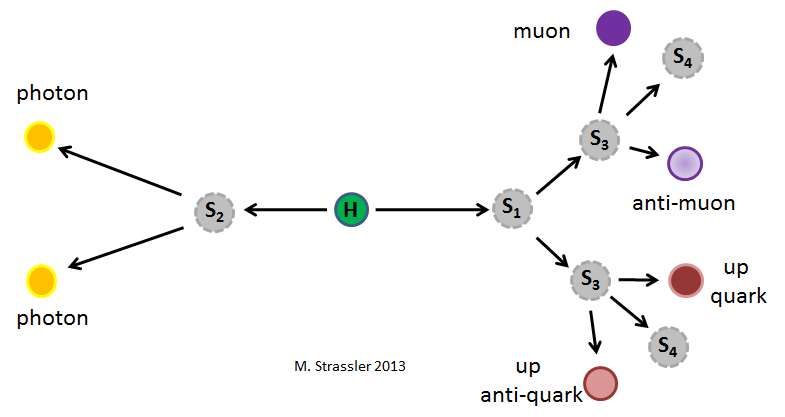
There are two last comments I should make for experts. First — just as for unusual production modes of the Higgs — while looking for signs that the new particle with a mass of 125 GeV/c² decays in a novel way, one should also keep in mind that other new Higgs-like particles might decay similarly and might not yet have been discovered. So (where appropriate) a blind search for the newly discovered particle should be accompanied by a non-blind search for particles with other masses. And second, the Higgs is not the only particle that might have unexpected decays and is produced in abundance. Searches for unusual (and likely rare) decays of top quarks, W and perhaps Z particles should also be attempted. This is relatively easy in the case of top and W decays, because top quark/anti-quark pair production gives us a huge sample of easily identifiable events in which to search for unexpected behavior either of top quarks or of the W particles to which they decay.


13 Responses
Thank you so much for sharing your insight on such an interesting topic!
I’ve got some details about the Higgs field I want to wrinkle out:
A1) Particles can exist in an excited state. Is the added mass ONLY due to the exciting energy or does the excited particle also interact more strongly with the Higgs?
A2) Is the following equation about the mass of a particle right?
m(0)c^2 = E(Higgs) + E(binding) + E(excite) + E(unknown)
where m(0) is the rest mass, E(Higgs) comes from the Higgs field, E(binding) is the inner binding energy of a combound particle, E(excite) is the extra energy from the excited state and E(unknown) is the yet unknown part of the picture.
B) Is myon just a mere excited electron? If not, what exactly is their difference in the Higgsian context — and would you please give us a good example of an excited particle.
Thankyou for this very enlightening article. But I have a question: Might it be feasible to use distributed computing, such as employed in the SETI Project (search for extraterrestrial signals), to assist in crunching the vast amounts of data accumulated at the LHC in the last two years?
LHC does have the crunching project. Look for Test4Theory.
P.S. :
I mean ; what is the relation between energy level and e-ripple ? physically not symbolically
If the e-field includes every single electron in the universe , and if every electron IS same vibrations in values of that e-field , then what mechanism directs and controls every single vibration in the whole universe to be identical to all other vibrations ?
What are the relations among electron energy levels and the identical fixed same value vibration of the e-field ?
TO PROFESSOR STRASSLER :
We send questions to you , wait for answers as if it is our right to get them while in reality it is your generosity who gives us the answers not our rights…….
THANKS PROFESSOR.
welcome
One of the greatest capability of the scientific mind is to look beyond what are seen…..
– As you did not mention WTC and techni-dilaton , can we infer that you reject that whole possibility ?
– I think that this article leads to a very strong inference ; that beyond our mighty search machines , there will always be something we missed…….this is the veiled reality concept.
I don’t reject those possibilities out of hand, but the data does not support them at all at this point.
The flip side of the analysis here, it would seem, is that if one spends a couple of years combing the existing data and doesn’t find anything not predicted by the Standard Model, then one has quite powerful exclusions of both non-Standard Higgs-like bosons and of a variety of hypothetical heavy particles (although the existing LHC limitations on the minimum mass of a t’, a W’, a Z’, or an LSP that fits simpler SUSY models, are already pretty strict).
As for hypothetical light particles, you sum of the issue quite neatly: “for such a lightweight particle to have been missed, it must be affected neither by the electromagnetic force nor by the strong nuclear force — nor even by the weak nuclear force, for particles much lighter than the Z or W particle.” The narrow window of 45 Gev (half of the Z mass) to 63 GeV (half of the Higgs mass), might, indeed, be a promising place to make a well focused search for electrically neutral, QCD colorless particles that haven’t been adequately probed so far – effectively heavy neutrinos – by looking at the percentage of missing traverse momentum in Higgs decays in a mass range where we previously couldn’t have probed them nearly as effectively.
But, if instead you are looking for a sterile particle, that doesn’t interact with the electromagnetic force, strong nuclear force, or weak nuclear force, the case that the LHC Higgs decays are a very worthwhile place to look for them doesn’t sound very convincing without some sort of more compelling theoretical prospect to motivate the search and narrow the search parameters, and prevent every piece of experimental error noise in the data from creating the illusion of new physics. It may make sense to look for your missing keys in the dark alley where you probably lost them and not under the streetlight. But, only if you have a flashlight to help you conduct the search.
But we do have a flashlight. That’s what the LHC is. The mistake is not to use it because it’s dark out there.
You say: “the case that the LHC Higgs decays are a very worthwhile place to look for them doesn’t sound very convincing without some sort of more compelling theoretical prospect to motivate the search and narrow the search parameters, and prevent every piece of experimental error noise in the data from creating the illusion of new physics.”
There’s plenty of theoretical motivation for this idea in any given year; but each year it changes. You may have noticed that theoretical motivation is not a time-independent quantity, so I don’t see why you view it as particularly reliable. And if you are going to rely on theoretical motivation more than on the capabilities of the LHC experiments, you’re giving theorists far too much credit and experimentalists far too little, in my opinion.
If you reject this, and if you would therefore like to make the case that this is just too hard and so we should quit, that’s up to you. I’m going to make the case that the field’s future is on the line and we should do what we can. It will certainly be a disaster if we choose now only to work on things that have theoretical motivation today, and 20 years from now, when the LHC is mothballed and there are no comparable high-energy accelerators, some bright person thinks of a new theoretical motivation, which turns out to predict something that was sitting in LHC data all along… something that could have been discovered if someone had simply tried to look.
Dear Prof. Strassler,
thanks again for such a nice article, I enjoyed this and the other one, where your explanations that not only minimal BSM models should be considered are quoted, a lot :-).
I hope you get the needed support and that the important searches for unexpected decays as you describe them here, weill actually be done .
What the heck are quirks? I have never heard about that …
Cheers
“quirks” are a speculative type of particle that I haven’t written about on this site (though I wrote papers about them.) Long story; not for today.